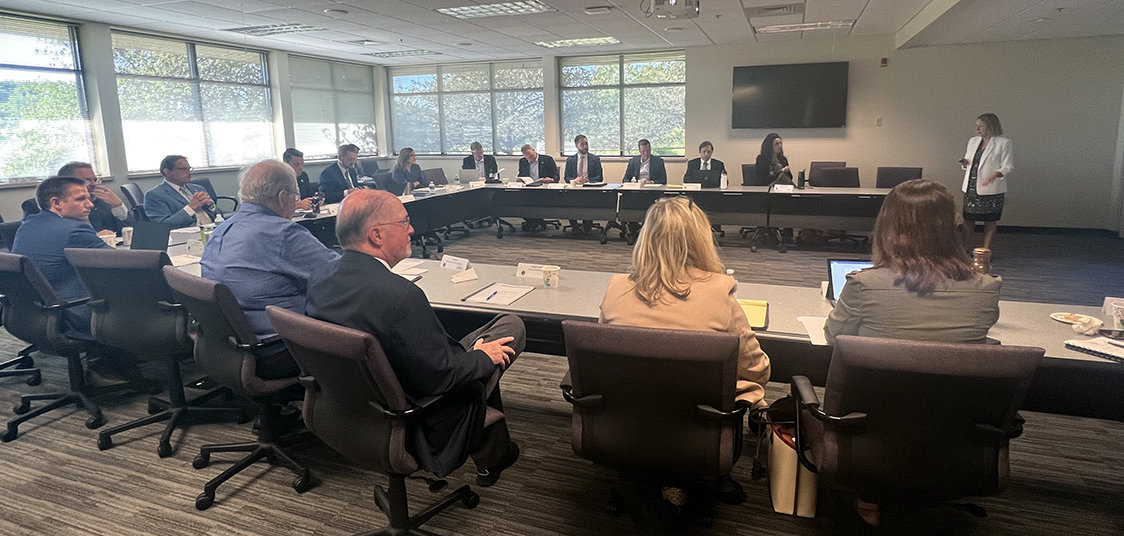WHA’s Public Policy Council met on Aug. 31, with WHA Senior Vice President Workforce and Clinical Practice Ann Zenk leading a conversation with the Council regarding barriers to licensure and proposing reforms that may break down obstacles to entry for health care workers in Wisconsin.
Zenk was appointed to serve as one of only two health care members and one of only five public members of the Legislative Council Study Committee on Occupational Licenses. This Committee first met on Aug. 2 and will meet again Sept. 27, with the goal of proposing reforms that could be considered in the next legislative session beginning January 2023.
Zenk discussed the benefits of expedited licensure established through the Wisconsin Act 10 process, but also discussed its challenges—which include awareness by third-party credentialing agencies, insurance companies and even federal agencies such as the Drug Enforcement Agency.
 Ann Zenk presents at WHA's Aug. 31 Council on Public Policy meeting.
Ann Zenk presents at WHA's Aug. 31 Council on Public Policy meeting.
“We have experienced a significant improvement in the last several months in both the awareness and utility of Wisconsin Act 10 licenses, including thousands of health care workers who have received their license through this process since it first began,” said Zenk. “But more can and needs to be done, particularly to help those new graduates and others who cannot utilize an Act 10 license but are waiting two months or longer to receive their license.”
In December 2021, the Wisconsin Office of the Commissioner of Insurance published a bulletin to all health plan issuers requesting that health plans “refrain from making coverage determinations” or “refuse to add a health care providers to its network based solely on the fact that a health care provider is operating under a temporary license.”
Zenk discussed proposals that could better utilize processes that employers already undertake, like background checks and third-party verification, to leverage—rather than duplicate—this work when an applicant employed by a hospital or health system applies for a Wisconsin license.
In addition, the Council discussed at length the necessity of additional licenses and registration requirements, noting that pharmacy technicians and genetic counselors will both be required to have a registration or licensure process soon as a result of legislation enacted this last session.
Zenk also led a discussion with Council members about the need to review renewal periods.
“We need to look at the data and see how necessary more frequent renewals are for license holders,” said Public Policy Council Chair and Hayward Area Memorial Hospital Chief Executive Officer Luke Beirl. “If there is no other consideration besides having a heartbeat for someone to have their license renewed, why do we require it?”
Children’s Wisconsin’s Jodi Bloch identified a concern with employers being able to see the status of an employee’s license in the new DSPS LicensE system, as employers attempt to assist their employees navigate Wisconsin’s occupational licensing process. Several members of the Council talked about the support employers can provide if they have access to licensure portal information.
Medicaid Workgroup develops recommendations for next state budget
WHA Senior Vice President of Public Policy Joanne Alig presented the WHA Medicaid Workgroup’s recommendations to the Public Policy Council during their Aug. 31 meeting. The Medicaid Workgroup is tasked with creating achievable policy solutions to the challenges WHA members face as they care for patients with Medicaid coverage.
According to Alig, Wisconsin hospitals are one of the strongest partners the state has in both care delivery to patients on Medicaid but also funding the Medicaid program through the hospital assessment. Alig described the function of Wisconsin’s hospital assessment, which delivers nearly two-thirds of all hospital payments for services provided to Medicaid recipients. In addition to providing payments to hospitals, the assessment also provides over $160 million annually in general support to the Medicaid program, which is projected to end the current biennium with a $414.5 million General Purpose Revenue surplus. Over the years, this allocation of hospital assessment dollars has become known as “the skim.”
WHA President and CEO Eric Borgerding noted how a large portion of “the skim” was initially used to expand coverage to childless adults with incomes up to 200% of the federal poverty level (FPL) in the late 2000s. However, Borgerding also noted, since 2014 Wisconsin’s Medicaid program limits eligibility to all those with incomes below 100% FPL while those living above the poverty line have been transitioned to subsidized coverage in the exchange.
Alig also briefed the Council on the continued transition of care from inpatient to outpatient settings. In 2007, the Medicaid shortfall to hospitals was approximately $600 million annually and split evenly between the inpatient and outpatient settings. Today, the shortfall has doubled to $1.2 billion annually and is primarily driven by outpatient services—comprising roughly 80% of this shortfall.
In addition to these core funding priorities, Alig has also been working with the Medicaid Workgroup on several other policies that address unnecessary and burdensome bureaucracies that make it more difficult to care for Medicaid patients or limit access to funding through quality improvement programs implemented by the Medicaid program through Medicaid managed care.
For more information or additional feedback regarding these policy priorities, WHA members should contact Ann Zenk or Joanne Alig.